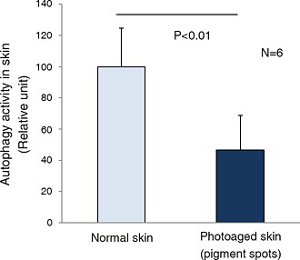Quantification of autophagy in skin: Autophagy decline associated with intrinsic aging and photoaging
This is an English translation of a news release in Japanese on November 18.
Research performed by the Biological Science Research Division of Kao Corporation (CEO: Mr. Michitaka Sawada) including consultation with Dr. Tamotsu Yoshimori, a distinguished Osaka University professor, has revealed that autophagy activity in skin declines with intrinsic aging and is associated with signs of photoaging such as pigment spots. Thus, autophagy is considered to have an important relationship with skin conditions related to aging as well as those caused by sun exposure because of effects on protein homeostasis.
Kao will present these research findings at the 29th annual meeting of the Japanese Society for Pigment Research in Okayama, Japan (November 23 to 24, 2019).
Autophagy
Autophagy (literal meaning "self-eating") is a natural system of degradation of cellular components that occurs in all cells in the body. During this process, isolation membranes first engulf unnecessary proteins or organelles, which produces micro-membrane vesicles termed autophagosomes. The autophagosome contents are then degraded into amino acids by lysosomal enzymes, which are recycled into new proteins. Indeed, the human body is in a constant state of self-renewal, with a recycling rate of 1% to 2% of total proteins. Autophagy has an essential role in providing fresh cellular components for the body through protein recycling.

Process of autophagy
Additional diverse functions of autophagy are known, though its activity decreases with aging. Autophagy inhibition is thought to be significantly involved in various age-related diseases, thus attempts to increase autophagy activity in older individuals are considered warranted for suppression of the effects of aging and aging-related diseases.
Background
Autophagy in skin is known to have some important roles, such as keratinization, immunity, and pigmentation, as well as others. Researchers at Kao began studies of skin autophagy in 2010 and published a scientific paper in 2013 regarding the role of autophagic melanosome degradation for determining skin color in consultation with Professor Tamotsu Yoshimori (Osaka University).*1 Since that time, Kao has been leading autophagy research studies in the field of skin science as well as examining applications related to skin care.
-
* 1 "Autophagy has a significant role in determining skin color by regulating melanosome degradation in keratinocytes" J. Invest. Dermatol. 133: 2416-2424 (2013).
Autophagy decreases with aging
Kao researchers examined the relationship of skin aging with autophagy using human skin tissues.*2
Six healthy female volunteers in their 40s and 50s were recruited for a skin biopsy study. Skin tissues were collected from a sun-protected site on the upper inner arm and protein extraction was subsequently performed. Autophagy activity in skin was determined by detecting changes in LC3 or p62 proteins.*3 The results obtained indicated a trend for decreased autophagy activity in skin in association with aging (Fig. 1).
-
* 2 Collection of skin tissues was conducted using a protocol previously approved by an institutional review board (IRB) in the United States and the Human Research Ethics Committee of Kao Corporation.
-
* 3 "How to interpret LC3 immunoblotting." Autophagy 3: 542-545 (2007).

Fig. 1. Autophagy activity associated with skin aging
Autophagy decline related to pigment spots as consequence of photoaging
Ultraviolet (UV) light, a leading cause of various types of skin damage, induces not only a sunburn/suntan response, but also accelerates symptoms of skin aging, such as pigment spots, wrinkles, and sagging, known as photoaging. Pigment spots in chronically sun-exposed outer forearm areas were compared with sun-protected normal skin areas on the upper inner arm in regard to autophagy activity. Those results showed that pigment spots on sun-exposed skin had a significantly lower level of that activity as compared with sun-protected healthy skin (Fig. 2).

Fig. 2. Inhibition of autophagy in pigment spots
Conclusion
In this study, Kao researchers successfully measured autophagy activity in skin, which revealed a decrease in association with chronological aging as well as in skin affected by photoaging (e.g., pigment spots). Based on these findings, we concluded that restoration of autophagy can contribute to improvement of skin damaged by various factors including aging and sun exposure, via normalization of protein homeostasis.
Kao will continue developments of novel technologies for skin beauty and health by continuing research of autophagy, an essential function in the human body.
About Kao
Kao creates high-value-added products that enrich the lives of consumers around the world. Through its portfolio of over 20 leading brands such as Attack, Bioré, Goldwell, Jergens, John Frieda, Kanebo, Laurier, Merries and Molton Brown, Kao is part of the everyday lives of people in Asia, Oceania, North America and Europe. Combined with its chemical division, which contributes to a wide range of industries, Kao generates about 1,500 billion yen in annual sales. Kao employs about 33,000 people worldwide and has 130 years of history in innovation. Please visit the Kao Group website for updated information.
Media inquiries should be directed to:
Corporate Communications
Kao Corporation
